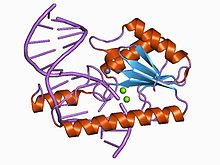| Vsr | |||||||||
|---|---|---|---|---|---|---|---|---|---|
 Crystal structure of a very short patch repair (VSR) endonuclease in complex with duplex DNA Crystal structure of a very short patch repair (VSR) endonuclease in complex with duplex DNA | |||||||||
| Identifiers | |||||||||
| Symbol | Vsr | ||||||||
| Pfam | PF03852 | ||||||||
| Pfam clan | CL0236 | ||||||||
| InterPro | IPR004603 | ||||||||
| SCOP2 | 1vsr / SCOPe / SUPFAM | ||||||||
| |||||||||
Very short patch (VSP) repair is a DNA repair system that removes GT mismatches created by the deamination of 5-methylcytosine to thymine. This system exists because the glycosylases which normally target deaminated bases cannot target thymine (it being one of the regular four bases in DNA).
The components of the system are MutS, which binds to the GT mismatch, the VSR endonuclease, which cuts the DNA, and MutL, which recruits the UvrD helicase.
VSR (very short patch repair) endonucleases occur in a variety of bacteria. They work by cutting, or rather, making a nick in DNA if the base pair is mutated or damaged.
Function
Mutations in the base pairs of DNA can be harmful to the organism. In particular, C to T mutations occur quite often due to methylation of cytosine. Hence, the VSR endonucleases have a function to protect the cell from damage caused by mutated DNA.
Mechanism
VSR recognises a TG mismatched base pair, generated after spontaneous deamination of methylated cytosines, and it creates a nick on a single strand by cleaving the phosphate backbone on the 5' side of the thymine. Then DNA Polymerase I removes the T and some nucleotides on the 3' strand and then resynthesises the patch.
Additionally, GT mismatches can lead to C-to-T transition mutations if not repaired. VSR repairs the mismatches in favour of the G-containing strand. In Escherichia coli, this endonuclease nicks double-stranded DNA within the sequence CT(AT)GN or NT(AT)GG next to the thymidine residue, which is mismatched to 2'-deoxyguanosine. The incision is mismatch-dependent and strand specific.
Structure
The structure of VSR is similar to the core structure of restriction endonucleases, which have a 3-layer alpha/beta/alpha topology.
VSR has three aromatic residues (Phe67, Trp68 and Trp86), which intercalate into the major groove, bending the DNA and separating the two strands. The N-terminal domain stabilizes the interaction between the protein and the cleaved product, thereby protecting the nick from DNA ligase until the arrival of DNA Polymerase I.
References
- Tsutakawa SE, Jingami H, Morikawa K (December 1999). "Recognition of a TG mismatch: the crystal structure of very short patch repair endonuclease in complex with a DNA duplex". Cell. 99 (6): 615–23. doi:10.1016/s0092-8674(00)81550-0. PMID 10612397. S2CID 17458432.
- Polosina YY, Cupples CG (2009). "Changes in the conformation of the Vsr endonuclease amino-terminal domain accompany DNA cleavage". J Biochem. 146 (4): 523–6. doi:10.1093/jb/mvp095. PMID 19556224.
- Bhagwat AS, Lieb M (June 2002). "Cooperation and competition in mismatch repair: very short-patch repair and methyl-directed mismatch repair in Escherichia coli". Mol. Microbiol. 44 (6): 1421–8. doi:10.1046/j.1365-2958.2002.02989.x. PMID 12067333. S2CID 44319240.
- Bunting KA, Roe SM, Headley A, Brown T, Savva R, Pearl LH (March 2003). "Crystal structure of the Escherichia coli dcm very-short-patch DNA repair endonuclease bound to its reaction product-site in a DNA superhelix". Nucleic Acids Res. 31 (6): 1633–9. doi:10.1093/nar/gkg273. PMC 152875. PMID 12626704.
| DNA repair | |
|---|---|
| Excision repair | |
| Homologous recombination | |
| Other pathways | |
| Regulation | |
| Other/ungrouped | |
This genetics article is a stub. You can help Misplaced Pages by expanding it. |